FDA VRBPAC: COVID-19 Vaccine Composition Going Forward
Tagged:COVID
/
JournalClub
/
PharmaAndBiotech
/
Politics
The FDA VRBPAC (Vaccines and Related Biological Products Advisory Committee) met this week to discuss the composition of vaccines going forward. In particular, should we consolidate on a series of bivalent shots instead of the current mixture of old and new?
Yeah, it’s been a while, hasn’t it?
It’s been… what, 26 days since I posted here?! And yes, this is being posted like nearly a week after the FDA VRBPAC meeting, because it’s a bit of a struggle for me.
Multissimae apologiae: I still have some post-COVID-19 brain fog and fatigue from our wrestle with COVID-19 last August here at Chez Weekend. There you can find 2 references to 2 papers [1] [2] saying it takes 6-9 months in the median to clear COVID-19 brain fog completely. That means, in the median, I should expect this mild cognitive impairment (it’s hard to take apart scientific papers right now!) to begin lifting in February - April. COVID-19 really did a number on me!
Perhaps relatedly, I’ve been depressed in ways sufficiently dangerous to make me bestir myself sufficiently to be prescribed anti-depressants again. I’ve finally climbed the dose ramp enough to be at the lower end of the clinically effective dose window, so now it’s 4-6 weeks to see if there’s an anti-depressant effect. So… February - April, again.
Also: dental surgery? Not as much fun as it sounds.
I’m sort of hoping this coming spring will be really good if we can pass by both Scylla and Charybdis.
But perhaps in the meantime I can write a bit via brute force, if not with the customary speed.
(And yes, comments are still broken. I can’t muster the energy to wrestle with cloud deployment of Staticman yet. Maybe soon, once I have enough brain cells firing simultaneously again. The email link at the top of every page still works, though.)
Our safari guides
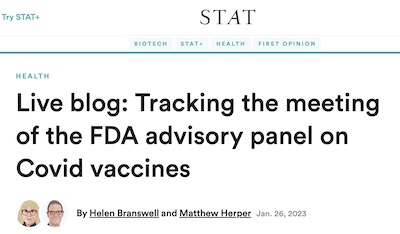 As per usual, our safari guides from STAT News are the redoubtable duo, Helen Branswell
& Matthew Herper. [3] They have a somewhat daunting
opener:
As per usual, our safari guides from STAT News are the redoubtable duo, Helen Branswell
& Matthew Herper. [3] They have a somewhat daunting
opener:
Fasten your seat belts, folks. We’re about to hit some turbulence.
If you’re reading this, you’re interested in the discussion on the future of Covid-19 vaccination that’s going to take place today in a meeting of the Food and Drug Administration’s Vaccines and Related Biological Products Advisory Committee. We at STAT can’t predict the outcome, but we know enough to expect that this meeting will feature some heated debate.
They point out that although 70% of the US has had the primary series (first 2 shots), booster uptake has been disgraceful and about 19% of Americans have had no doses at all. That 19% is probably unreachable now by anything short of legal force. So future vaccination programs must be aimed at the rest of us: can we narrow down the multiple brands, doses, and compositions of the vaccines?
In particular, can we ditch the original Wuhan strain used now in the primary series in favor of bivalent vaccines all around?
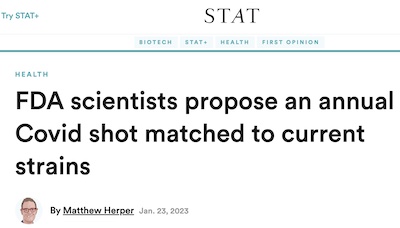 Even more so: can we agree to a policy of annual updates, e.g., look around in summer to
see which SARS-CoV2 strains are in circulation to make a multivalent booster available in
the fall? We do this all the time for flu, so maybe we should do it here. The FDA
itself has even proposed this with annual COVID-19 boosters [4],
though they’re not brave enough to do it without VRBPAC sign-off.
Even more so: can we agree to a policy of annual updates, e.g., look around in summer to
see which SARS-CoV2 strains are in circulation to make a multivalent booster available in
the fall? We do this all the time for flu, so maybe we should do it here. The FDA
itself has even proposed this with annual COVID-19 boosters [4],
though they’re not brave enough to do it without VRBPAC sign-off.
NB: Vaccines discussed at this VRBPAC were Moderna, Pfizer/BioNTech, and Novavax. J&J will not be discussed, as: (a) it did not achieve the “one & done” single-shot advantage hoped for, (b) it’s lower efficacy, (c) it’s associated with some rare clotting disorders, and (d) it hasn’t been updated for new strains or a multivalent formulation. J&J is ramping down production of its vaccine.
Branswell & Herper’s liveblog summary is worth reading, if you don’t want to read the primary source material (or, for that matter, the rest of this blog post).
Primary data sources
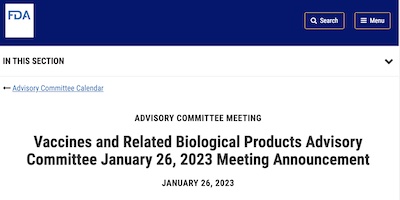
As per usual, the FDA’s VRBPAC meeting announcement [5] contains pointers (bottom of the page) to all the presentations (as well as administrative matters, like who is in attendance, who has conflicts of interest, and that sort of thing).
As is also usual in these matters, the materials are supposed to be available several days in advance for public comment. In practice, a skeleton announcement goes up in advance, but the main slide decks appear only at the last minute on the morning of the meeting, because people always want to tweak until the last minute. C’est la vie.
There is also on that page a link to the YouTube video capturing the whole meeting, in case you want to sit through a day-long video. (In which case: what’s wrong with you?!)
Meeting Discussion Topics & Voting Question
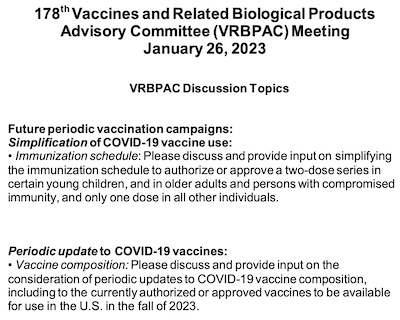 The meeting discussion topics [6] are pretty clear:
The meeting discussion topics [6] are pretty clear:
- Whether we can simplify the current kludge of multiple different vaccines and schedules. Right now you have to receive 2 doses against the Wuhan strain, which is for all practical purposes extinct. (It does give some cross-immunity, though.) Only then are you eligible for the current bivalent booster that is closer to, but not exactly the same as, the current strains. Surely we can just start by using whatever the current multivalent booster is, and maybe do 1 annual boost for most people and 2 for the old, some of the young, and the immunocompromised?
- How should we adjust the composition of the vaccines to respond to future variants? We do this every year for influenza: in spring look at what’s circulating in the southern hemisphere winter, and adjust our fall vaccine composition accordingly. Surely we can do something like that, and not always be behind the virus?
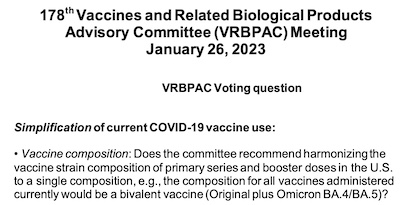 Interestingly, though there are 2 discussion topics, there is only 1 voting
question. [7] That’s the one about how to update the
vaccine composition, but not about harmonizing the dose schedule.
Interestingly, though there are 2 discussion topics, there is only 1 voting
question. [7] That’s the one about how to update the
vaccine composition, but not about harmonizing the dose schedule.
I wonder why? It appears they want to entertain discussion and hear opinions, but don’t want to be (nearly) bound by the result. That’s… curious, though not unprecedented.
Meeting presentations
FDA briefing document
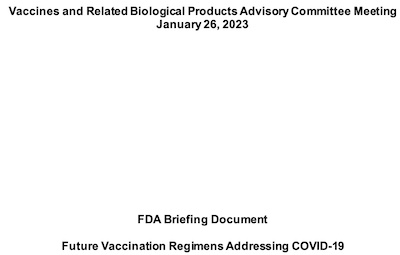 Pride of place should first be given to the FDA’s official briefing
document [8] I say “should”, of course, because I’m going to
do no such thing. These documents are notoriously dense and difficult to read, and their
content is more clearly presented in the slides from the meeting participants anyway. So
that’s 25 pages of word salad with no figures and no meaningful tables that I can skip.
(Still, if you really want to dive in, check the references.)
Pride of place should first be given to the FDA’s official briefing
document [8] I say “should”, of course, because I’m going to
do no such thing. These documents are notoriously dense and difficult to read, and their
content is more clearly presented in the slides from the meeting participants anyway. So
that’s 25 pages of word salad with no figures and no meaningful tables that I can skip.
(Still, if you really want to dive in, check the references.)
Let’s work through the talks in the order they were presented, according to the meeting agenda. [9]
FDA: Considerations for simplification of schedules & periodic updates
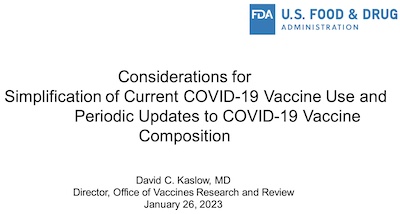 First up is a brief talk by David Kaslow, of the Office of Vaccines Research and
Review. [10] He’s got several things to say about process and
how the discussion will be structured, which is of interest only if you want to know how
these meetings work.
First up is a brief talk by David Kaslow, of the Office of Vaccines Research and
Review. [10] He’s got several things to say about process and
how the discussion will be structured, which is of interest only if you want to know how
these meetings work.
The relevant part of his presentation is teeing up the discussion questions:
- Can we simplify the COVID-19 vaccination process down to a single composition of vaccine and a less complex dose schedule (maybe based on age and other risk factors)?
- Can we make periodic updates to the vaccines to account for new strains, as we do now for influenza?
Yes, it’s sort of a formality. But without this sort of formality, meetings tend to go off the rails & into the weeds.
CDC: Current SARS-CoV2 epidemiology
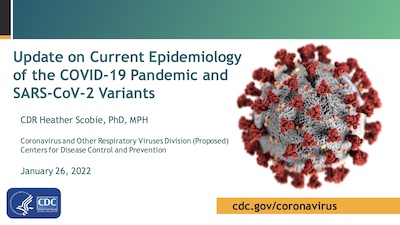 The first content-oriented presentation was from Heather Scobie of the CDC, on the current
epidemiology of SARS-CoV2. [11]
The first content-oriented presentation was from Heather Scobie of the CDC, on the current
epidemiology of SARS-CoV2. [11]
She makes a number of timely points:
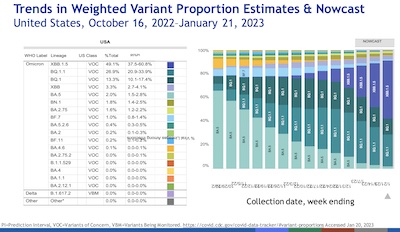
-
The trend in variant proportions is the usual ominous thing: yet another variant, even more infectious than the past, is taking over. In the US as a whole, that appears to be the Omicron subvariant XBB.1.5 (an evolutionary descendant of Omicron/BA.2). You can see this graphically from the plot of variant proportions over time (though the axis labels are garbled); if you look at the table the 95% confidence limits confirm this in a more objective way: the 95% LCL for XBB.1.5 is above the 95% UCL for the next most frequent variant, BQ.1.1. So it’s real, sadly enough.
At least XBB.1.5 seems to be less likely to kill, though I don’t know if that’s a property of the virus or a property of a population that’s got more immunity (than vaccination + previous infection) than we had in 2020 - 2021.
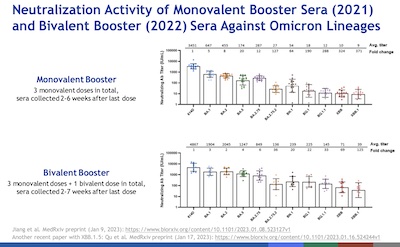
- Next she shows us the ability of blood sera from people with monovalent vs bivalent
boosters to neutralize various viral variants, due to antibody activity. Without diving
into the weeds, higher is better on the vertical scale, and the vertical scale is
logarithmic. (There’s some reasonable discussion to be had about the fact that
antibodies aren’t everything, and we should include T cell and memory B cell activity.
But antibody activity is what we can easily measure right now.)
- Both monovalent & bivalent vaccination have some activity against all strains, but mostly against the early strains.
- But look at the numbers: the activity of the bivalent booster against XBB.1 is about 4x higher than monovalent.
- There are some interesting facts about hospitalization and death rates.
- First, as expected, the death rates stratified by age show the highest rate among the elderly.
- Second, very much not as I expected, the highest hospitalization rates are among the very young! Infants (< 6mo) and toddlers (< 24mo) are the most frequently hospitalized, perhaps because they are also the least vaccinated. So all those rubrics about children having no significant risk are apparently empirically false. (There are tables on subsequent slides that make this clear, showing the hospitalization and death rates, normalized by age cohort size.)
So vaccinating your kids, even youngsters, seems like an excellent idea.
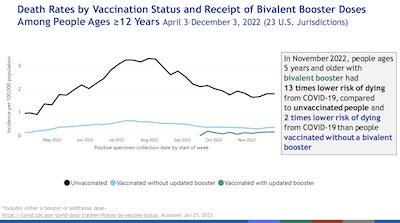
- Finally, she shows the miserable rate of bivalent booster uptake in the US (only 16%),
and the rather grim consequences of that.
- The unvaccinated die at very high rates indeed.
- The vaccinated are far more fortunate.
- But those most fortunate are those with the latest bivalent booster.
So getting the bivalent booster is a sensible move for anyone wishing not to die needlessly, which should include everyone who can medically tolerate the bivalent booster.
So that’s the epidemiological situation: not as grim as 2020 - 2021, but still not pretty. Fortunately, vaccination is an effective strategy. Now if we only had an effective communications strategy to convince people of this…
CDC: Vaccine efficacy
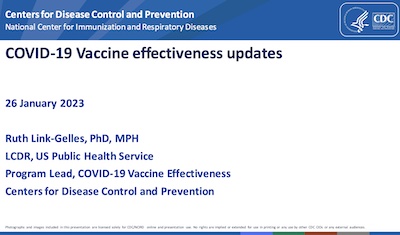 Next was a presentation by Ruth Link-Gelles of the CDC [12]
on vaccine efficacy (VE) of:
Next was a presentation by Ruth Link-Gelles of the CDC [12]
on vaccine efficacy (VE) of:
- monovalent mRNA vaccines against symptomatic infection in children,
- bivalent mRNA vaccines against symptomatic infection by XBB lineages in adults, and
- bivalent mRNA vaccines vs hospitalization in older adults.
Whenever discussing VE, it’s important to state: (a) the population, (b) they viral lineage extant at the time of data collection, and (c) the criteria for calling a positive (typically symptoms, severe disease, hospitalization, or death). Different choices will lead to different results, largely incomparable to the results with other choices, so it’s important to know what the efficacy number means!
Monovalent VE vs symptoms in children
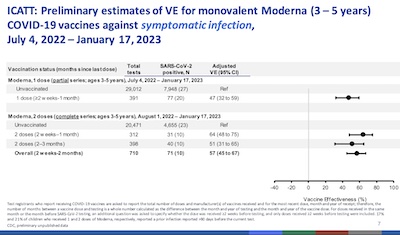
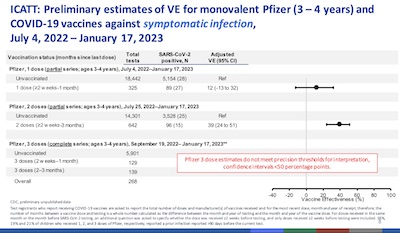 Do the monovalent vaccines work, or work well enough, in pediatric applications? Either
just barely, or maybe not even that:
Do the monovalent vaccines work, or work well enough, in pediatric applications? Either
just barely, or maybe not even that:
- Her first result is that we have miserable booster uptake in the US, and in fact very low uptake of the primary series in young folk: 3.3% in < 2yr and 5.1% in < 5yr.
- Add to that the fact that the VE of monovalent vaccines vs symptomatic infection is just not that strong in young people: Moderna is 57% (CL: 45% – 67%), and Pfizer’s 3-shot program is too variable to tell (CL > 50%, presumably due to sparse data). So we definitely need better pediatric vaccines, presumably like the multivalent booster.
Bivalent VE vs XBB symptoms in adults
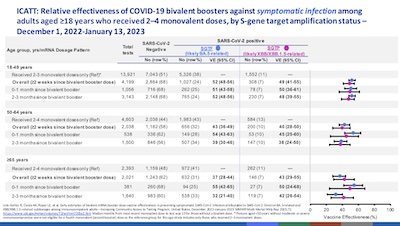 How about the bivalent vaccines against symptomatic infection in adults? Looks like the
efficacy is generally pretty good:
How about the bivalent vaccines against symptomatic infection in adults? Looks like the
efficacy is generally pretty good:
- It seems they looked at Pfizer and Moderna together, or at least I could find no separate analyses.
- They used 2 different amplification techniques to assess for BA.5 and XBB/XBB1.5 (BA.2) variants being present.
- They also stratified into 3 age groups.
Result: efficacy was remarkably stable, ranging for the most part from 40% – 50%. In the very worst case the VE lower confidence limit was about 26%, so bounded well above 0%: the vaccines did actually help. (Recall “symptomatic infection” is a high bar to clear! We really care about hospitalizations and deaths.)
Bivalent VE vs hospitalization in older adults
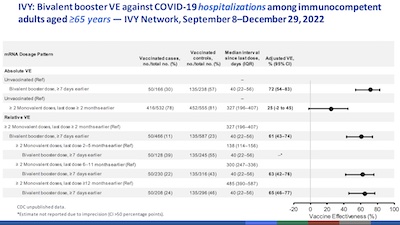 The punchline is really just the top 2 datapoints shown on this slide:
The punchline is really just the top 2 datapoints shown on this slide:
- With a bivalent booster, the elderly hospitalization VE is 72% (CL: 54% – 83%), which is very nice indeed.
- On the other hand, for elders with just 2 monovalent doses (i.e., the primary series alone), the VE is only 25% (CL: -2% – 45%). That is, at the 95% confidence level, it is not distinguishable from 0!
So the moral is clear for elders: get the bivalent vaccine, to maximize your chances of staying out of the hospital. Somewhat surprisingly (to me): also kids are at significant risk of hospitalization without the bivalent booster.
mRNA bivalent booster safety analysis
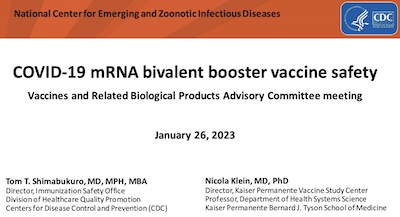 Next is a study of bivalent booster safety, by Tom Shimabukuro (Immunization Safety Office
of the CDC) and Nicola Klein (Director of Kaiser Permanente Vaccine Study
Center). [13] Much of this was about their methodology and
how they study risk, so we’ll skip that part. Also, we’re almost certain the bivalent
vaccine is safe, certainly safer than COVID-19, so this is probably belt-and-suspenders
thinking.
Next is a study of bivalent booster safety, by Tom Shimabukuro (Immunization Safety Office
of the CDC) and Nicola Klein (Director of Kaiser Permanente Vaccine Study
Center). [13] Much of this was about their methodology and
how they study risk, so we’ll skip that part. Also, we’re almost certain the bivalent
vaccine is safe, certainly safer than COVID-19, so this is probably belt-and-suspenders
thinking.
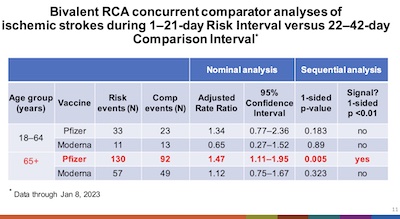 But… that’s not quite what was found! As you can see from their slide 11 shown
here, there was a stroke signal seen, for Pfizer only, for older subjects only, for
strokes. When this was announced by the FDA on Jan 13, to much uninformed consternation,
they said it was “unlikely to be related” to vaccination. Let’s dig into the data and see
if we can understand why they said that, and whether we agree:
But… that’s not quite what was found! As you can see from their slide 11 shown
here, there was a stroke signal seen, for Pfizer only, for older subjects only, for
strokes. When this was announced by the FDA on Jan 13, to much uninformed consternation,
they said it was “unlikely to be related” to vaccination. Let’s dig into the data and see
if we can understand why they said that, and whether we agree:
- The way the study was designed, they counted events in the first 3 weeks after
vaccination, and compared those to events in the same group of people in weeks 4-6.
- If the events right after vaccination were statistically significant higher (at the stringent significance level $p \le 0.01$), then a red flag went up.
- Also, they computed the Risk Ratio ($RR$) between the 2 periods. If its 95% confidence limit was bounded above 1, then a red flag went up.
- As you can see here, all groups are in the clear except over 65 and Pfizer: $RR \gt 1$, $\mathrm{LCL}(RR) \gt 1$ and $p \lt 0.01$.
- But for the over-65 Pfizer crowd, there was a signal. Let’s use our binomial
confidence interval of ratios code [14] to check the $RR$
here and see if we believe their numbers.
- This code was made for vaccine efficacy ratios, so we have to subtract its result from 1, which will swap the UCL and LCL. But I’m not gonna write a new script just for this, so cope!
- Also, they don’t tell us how many people were in the trial, so we have to guess the
number. Fortunately, since the people in weeks 1-3 and the people in weeks 4-6 are
the same people, that divides out in the central estimate and does not affect the
confidence limits strongly (which we verified numerically). So we’ll just go with a
nice big $N=10^5$ subjects:
> 1 - efficacyAndCL(100000, 130, 100000, 92) LCL Eff UCL 1.843864 1.413043 1.082901 - So basically we get $RR = 1.41$ with confidence limits of $(1.08, 1.84)$. This compares reasonably favorably with the reported result shown on slide 11 of $RR = 1.47$ (CL: $1.11 - 1.95$). (At least, within the limits of the very crude statistic we’re using for comparison!)
- So we believe their result.
On the other hand, a number of things about this result are hinky:
- In the discussion, it turned up that other databases with similar data don’t see this
effect, i.e., it’s a one-time-only thing.
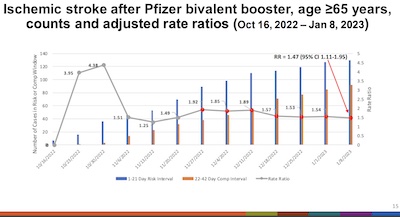
- Speaking of time, look at their slide 15, shown here. See how the events all cluster in
the early days of the trial, and then disappear? The risk ratio peaks at 4.38 (!), but
then declines to 1.47 at the end, diluted by all those days of normal rates of events.
Something is very fishy here, because the early participants should be no different from
the later participants, and vaccine-wise are in fact identical.
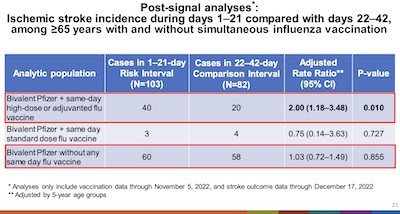
- Next, consider their slide 21, shown here. It shows that:
- If people got either no flu vaccine or a normal dose flu vaccine on the same day, then there was no effect.
- But if people got an adjuvanted flu vaccine (an additive to make it have stronger immune stimulation) or high-dose flu vaccine (again stronger immune stimulation for elders), then there was an effect.
- They don’t go so far as to show the high-dose flu vaccines were co-administered in the first part of the trial but not the second (to be consistent with the time clustering above), but this is another thing that directs attention away from the COVID-19 vaccine and toward something else.
- We note here on this Crummy Little Blog That Nobody Reads (CLBTNR), that the effect happened for Pfizer, not for Moderna. This, in spite of the fact that the vaccines are nearly identical, and Pfizer is dosed lower. Very odd, indeed!
- Finally, as Branswell & Herper point out, one of the VRBPAC panelists (Arthur Reingold, UC Berkeley) pointed out that the relevant signal comparison was to the rate of stroke in COVID-19 patients. That is, there can be stroke risk in vaccinees, but it’s still better than getting COVID-19!
So there are several reasons not to associate this stroke signal with the vaccine:
- It was a one-study-only effect not seen elsewhere.
- The effect happened in a limited time window and didn’t repeat.
- It looked like it was somehow related to high-dose flu vaccination at the same time.
- It didn’t replicate with Moderna.
- COVID-19 has significant stroke risk probably greater than this anyway.
So it’s easy to see how the FDA could say it was “unlikely to be related” to COVID-19 vaccination, given all the inconsistencies around the edges.
That being said, here at Château Weekend, your humble Weekend Editor and the exalted Weekend Editrix both got Moderna and high-dose flu vaccinations on the same day (albeit before this was known). We’re fine.
mRNA bivalent booster safety analysis, redux
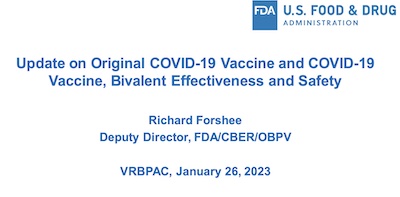 Next was another safety/efficacy evaluation of the bivalent vaccines, this time by the
FDA itself, presented by Richard Forshee. [15]
Next was another safety/efficacy evaluation of the bivalent vaccines, this time by the
FDA itself, presented by Richard Forshee. [15]
This talk reports analyses of medical records of millions of people, with therefore very high statistical significance. Some are Medicare, some from insurance companies, some from hospitals,… a little bit of everything available.
They have 2 important results, which we’ll summarize instead of presenting slide-by-slide:
-
No stroke signal for Pfizer or Moderna, in contrast to the previous study. The risk ratio for the study remained below 1, of which the authors say: “We reached the maximum length of surveillance without a signal”. Also, there was no relationship to simultaneous flu vaccination.
However: Just in case, the FDA is doing a formal epidemiological study on the risks of co-vaccination vs flu and COVID-19 in 2023-2024. They’re taking this seriously, despite every indication it’s a fluke.
-
The real-world efficacy vs death and hospitalization in nursing home patients (at the highest risk) is much better with the bivalent booster than without. E.g., VE vs death is 88.7% for bivalent and only 55.7% with monovalent, during the Delta wave. Basically, the bivalent vaccines are better.
Well, that’s a relief. Yet more reason to disregard the hinky stroke signal above.
NIH study of multivalent vaccines
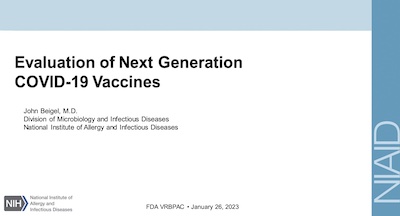 Next was an evaluation of “next-generation” COVID-19 vaccines by John Beigel at the
NIH and NIAID. [16] He’s using “next-generation” here to mean
future multivalent vaccines, nasal vaccines, pan-coronavirus vaccines, and vaccines with
something beyond the spike protein (e.g., target protein + nucleocapsid protein, which is
less variable). However, that’s mostly speculative and the bulk of my interest in his
talk is in the background information.
Next was an evaluation of “next-generation” COVID-19 vaccines by John Beigel at the
NIH and NIAID. [16] He’s using “next-generation” here to mean
future multivalent vaccines, nasal vaccines, pan-coronavirus vaccines, and vaccines with
something beyond the spike protein (e.g., target protein + nucleocapsid protein, which is
less variable). However, that’s mostly speculative and the bulk of my interest in his
talk is in the background information.
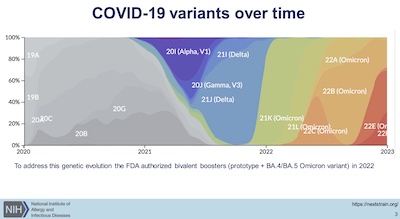 He’s got a nice cartoon portrayal of the relative abundance of the viral variants in the
US over time, shown here. It doesn’t really tell us much that we probably don’t all know
already, but it does so in a way that was visually striking to me. Interesting point:
after about 2022-Nov, it’s all Omicron, all the time. Nothing but Omicron variants from
there on out.
He’s got a nice cartoon portrayal of the relative abundance of the viral variants in the
US over time, shown here. It doesn’t really tell us much that we probably don’t all know
already, but it does so in a way that was visually striking to me. Interesting point:
after about 2022-Nov, it’s all Omicron, all the time. Nothing but Omicron variants from
there on out.
So it made sense to make a bivalent Omicron-based booster. The older variants are (almost?) extinct and thus including the original Wuhan variant in the latest booster was likely an extreme excess of caution. I mean, it didn’t hurt, but it also didn’t help.
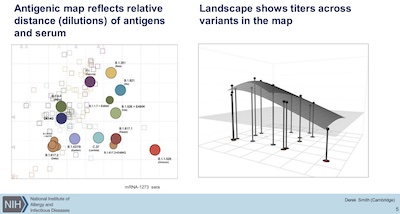 Beigel went on to use his “antigenic space” method to portray both the sera of recovered
patients and the viral variants in the same 2-d space. This is apparently nearly the same
method that he used in the
VRBPAC of 2022-Apr-08,
where the participants described it as “complex” and “very hard to judge.” Don’t get me
wrong: I’m probably a bigger fan of
multidimensional scaling
and singular value decomposition
than the next guy! But there comes a time when your client just refuses to try to
understand what you’re saying, and it’s time to try saying it another way.
Beigel went on to use his “antigenic space” method to portray both the sera of recovered
patients and the viral variants in the same 2-d space. This is apparently nearly the same
method that he used in the
VRBPAC of 2022-Apr-08,
where the participants described it as “complex” and “very hard to judge.” Don’t get me
wrong: I’m probably a bigger fan of
multidimensional scaling
and singular value decomposition
than the next guy! But there comes a time when your client just refuses to try to
understand what you’re saying, and it’s time to try saying it another way.
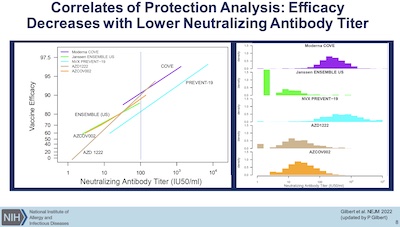 Periodically, people complain about using neutralizing antibody titers as a proxy for
real-world protection. They have a point: antibodies are short-term protection, whereas
the longer-term protection we all want is in T cell and memory B cell responses.
Periodically, people complain about using neutralizing antibody titers as a proxy for
real-world protection. They have a point: antibodies are short-term protection, whereas
the longer-term protection we all want is in T cell and memory B cell responses.
Here, Beigel does us a service: he measures the correlation between vaccine efficacy (rate of infection in various cohorts) and their corresponding antibody levels. Imperfect as antibodies may be in a physical world modeling sense, they are at least strongly correlated with vaccine efficacy. (A point against Beigel: he doesn’t report an $R^2$ or show the regression details, just draws in some presumed regression lines of attractively positive slope. C’mon, man!)
So… certainly not perfect, but maybe good enough to be getting on with?
There’s also some discussion about nasal vaccines and other new technologies, but it’s all pretty speculative at this point so I won’t go over that.
He reaches 2 broad conclusions:
- Efficacy: Severe > Symptomatic >> asymptomatic & transmission
- Next gen vaccines: must do better, and there’s some confusion about what to measure (nasal, oral, pulmonary samples)
Next came the 3 vendor presentations from Moderna, Pfizer, and Novavax.
Moderna presentation
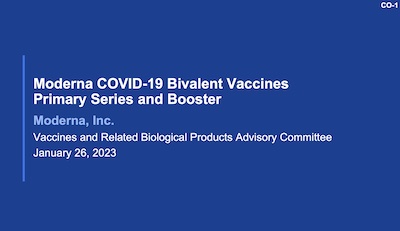 Moderna’s presentation [17] details a bunch of studies
they’ve done on the Wuhan + BA.1 bivalent and the now-EUA’d Wuhan + BA.4/5 bivalent
vaccine. (And a certain amount of yay-rah corporate propaganda, which we all expect and
discount accordingly.)
Moderna’s presentation [17] details a bunch of studies
they’ve done on the Wuhan + BA.1 bivalent and the now-EUA’d Wuhan + BA.4/5 bivalent
vaccine. (And a certain amount of yay-rah corporate propaganda, which we all expect and
discount accordingly.)
To be honest, I was both pleased and a bit disappointed in what I saw here. Disappointed, because there wasn’t much new that we didn’t already know or could infer from the previous FDA/CDC/NIH presentations. On the other hand, pleased because that’s pretty good news: the bivalent vaccines work, and are safe. We now have that documented very, very thoroughly.
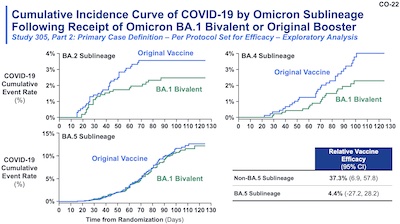 Consider, for example, their slide 22, shown here. It shows Kaplan-Meier curves, with the
incidence of COVID-19 on the vertical axis (lower is better) and time since vaccination on
the horizontal axis. The original vaccine is shown in blue, and the (old) BA.1 + Wuhan
bivalent vaccine is in green. We’re looking at 3 Omicron-class viral variants: the BA.2
sublineage, the BA.4 sublineage, and the BA.5 sublineage.
Consider, for example, their slide 22, shown here. It shows Kaplan-Meier curves, with the
incidence of COVID-19 on the vertical axis (lower is better) and time since vaccination on
the horizontal axis. The original vaccine is shown in blue, and the (old) BA.1 + Wuhan
bivalent vaccine is in green. We’re looking at 3 Omicron-class viral variants: the BA.2
sublineage, the BA.4 sublineage, and the BA.5 sublineage.
The clear conclusion: the bivalent mixture is superior against BA.1 and BA.4, and non-inferior against BA.5. This is what we expected, but also what we want to see.
Good news… ho hum.
Good job, though. I’m glad to have gotten the Moderna Wuhan + BA.4/5 bivalent.
Pfizer presentation
 To be honest again, I had about the same reaction to Pfizer’s
presentation. [18] It’s slightly disappointingly just stuff
we already knew, could have inferred, or guessed with very high plausibility. On the
other hand, it’s all good news that the bivalent boosters really, really work better.
To be honest again, I had about the same reaction to Pfizer’s
presentation. [18] It’s slightly disappointingly just stuff
we already knew, could have inferred, or guessed with very high plausibility. On the
other hand, it’s all good news that the bivalent boosters really, really work better.
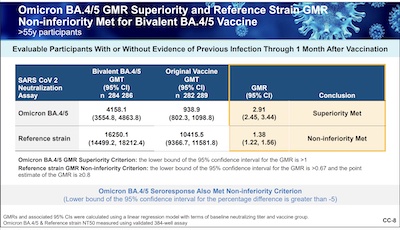 Here, for example, is their slide 8 showing the results of a comparison of the BA.4/5 +
Wuhan bivalent booster versus the original vaccination. (This is in subjects aged > 55
years; there’s a similar slide for younger people showing the same result.) It shows, in
particular detail, 2 bits of good news (that we probably guessed and hoped would be the case):
Here, for example, is their slide 8 showing the results of a comparison of the BA.4/5 +
Wuhan bivalent booster versus the original vaccination. (This is in subjects aged > 55
years; there’s a similar slide for younger people showing the same result.) It shows, in
particular detail, 2 bits of good news (that we probably guessed and hoped would be the case):
- The new bivalent vaccine is superior to the classic vaccine when it encounters BA.4/5. This is to be expected, since it contains spike protein specific to BA.4/5, whereas the old vaccine has to rely on cross-immunity of the “kinda similar” Wuhan strain.
- The new bivalent vaccine is non-inferior to the old vaccine, when presented with the old virus. The old virus is more or less extinct, but this still matters: the old virus can’t come roaring back to bite us all once again if we switch to the new vaccine.
So, yeah.
Good news. Ho hum. :-)
One interesting tidbit that came out in discussion: Pfizer says it needs 100 days from the time the strain is selected to producing a new vaccine. So if we select a new strain at the beginning of June, we can expect vaccine starting to be available in mid-September in time for a winter booster campaign. Moderna didn’t say specifically the time requirement, but they didn’t object to this. Novavax, which makes a protein-based vaccine, can’t make this timeline: they need to know by early spring to adjust their protein manufacturing pipeline.
That’s one of the (many) benefits of the mRNA vaccine technology.
Novavax presentation
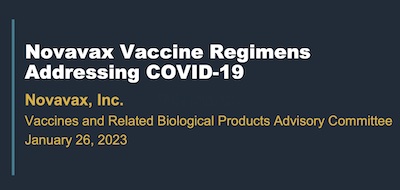 The 3rd vendor, less well known, is Novavax. [19] They
make a more traditional protein-based vaccine, which takes a bit more time to develop in
the first place and to adapt to new strains. They have not yet made a bivalent vaccine.
The 3rd vendor, less well known, is Novavax. [19] They
make a more traditional protein-based vaccine, which takes a bit more time to develop in
the first place and to adapt to new strains. They have not yet made a bivalent vaccine.
My guess is their main raison d’être is to be an alternative for people still superstitiously suspicious of mRNA vaccines. (Well, anything that gets them vaccinated, so they live and not die, says me.)
Right out of the gate, they say their existing vaccine has lower response to BQ.1.1 and XBB.1 variants, due to mutations in otherwise-conserved epitopes on the spike protein. Disappointing, but again to be expected.
However, they now have a couple prototype strain vaccines vs BA.1, BA.2, and BA.5. They have a bunch of studies showing these more or less work, though their manufacturing pipeline is significantly less agile than the mRNA pipelines.
FDA consideration on strains for future multivalent vaccines
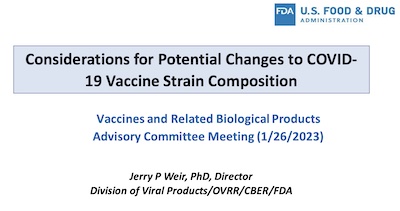 Finally, there was one more presentation from the FDA, presented by Jerry Weir, on
considerations for choosing the viral strains go to into future
vaccines. [20] This has been discussed at previous VRBPAC
meetings (which this Crummy Little Blog That Nobody Reads summarized on
2022-Apr-08 and
2022-Jun-28).
Finally, there was one more presentation from the FDA, presented by Jerry Weir, on
considerations for choosing the viral strains go to into future
vaccines. [20] This has been discussed at previous VRBPAC
meetings (which this Crummy Little Blog That Nobody Reads summarized on
2022-Apr-08 and
2022-Jun-28).
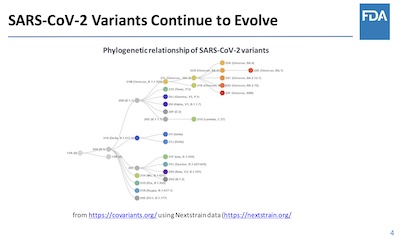 As a point of side interest, he showed us the latest phylogenetic tree of the viral
variants. It’s really interesting to me to see that Delta was so thoroughly dominant last
year, but now Omicron is even though it evolved from a completely different, and older
branch of the tree. Those old viruses are still out there, still conniving to kill us
better.
As a point of side interest, he showed us the latest phylogenetic tree of the viral
variants. It’s really interesting to me to see that Delta was so thoroughly dominant last
year, but now Omicron is even though it evolved from a completely different, and older
branch of the tree. Those old viruses are still out there, still conniving to kill us
better.
After some discussion of the epidemiology (which we’ve already seen) and the improved antibody titers from the bivalent vaccines (which we’ve also already seen), he gets on to his main point: we need to simplify vaccination. There should be probably just 1 vaccine, a multivalent reflecting the current strains and maybe some insurance against past strains. Also, the schedule for who gets boosted when and how often needs to be simplified.
With regard to the boosting schedule, he suggests (slide 17):
- The general population (most adults, older children, and young children previously immunized) should get 1 booster a year.
- Higher-risk older adults, the immunocompromised, and young children with no previous vaccination should probably get 2 boosters a year.
You can like it or not, but at least it’s (pretty) clear and simple.
With regard to vaccine composition, he suggests:
- Strain surveillance leading to a VRBPAC meeting in May or early June to decide what strains pose a public health threat. (Emergencies could of course make the VRBPAC convene at any time, as has been done in the past for H1N1 influenza.)
- Manufacturers target September for initial vaccine delivery. NB: Pfizer/BioNTech and Moderna can do this with their mRNA pipelines, but Novavax cannot meet this deadline with their protein-based vaccine (they would need to know by early spring).
Meeting discussion & voting
Well, that was quite a huge pile of presentations, most of which said what seemed to be the Obvious Correct Thing. Branswell & Herper were expecting quite fractious debate. And there was some, but not very much; it was about:
- what the T cells are doing,
- when vaccines should be given (no clear COVID-19 seasonality yet, but the seasonal strain of flu and RSV is clear, so getting COVID-19 vax to relieve hospital strain from those might make sense),
- how long to give manufacturers to update for new strains,
- what input the rest of the world has into strain selection,
- how a 2-shot régime for little kids interacts with Pfizer’s 3-shot paradigm,
- how we will develop better vaccines like nasal mucosal vaccines & pan-coronavirus vaccines, … and so on. Notably, not much about the voting or discussion questions.
The voting question, shown above, was about the Obvious Correct Thing: should we harmonize all the vaccinations to be the same multivalent mixture that is appropriate that year? This passed, 21 yes votes to 0 no votes. Unanimous VRBPAC verdicts are not that frequent, so this is a pretty strong endorsement. (The FDA management has to endorse this formally for it to take effect.)
Not everybody on the VRBPAC liked the idea of annual boosters going forward; some wanted to see more data in the future before committing to this. But it makes sense to your humble Weekend Editor that we should prepare now for that eventuality. The CDC’s ACIP (Advisory Committee on Immunization Practice) will have something to say about that.
The Weekend Conclusion
It seems like this was an awful lot of machinery to crank up just to come to the only sensible conclusion? Even though, as we’ve previously noted on this Crummy Little Blog That Nobody Reads, they’ve previously promised to review COVID-19 vaccine composition quickly like they already do with flu vaccines.
My personal guess is that a lot of this is due to 2 reasons:
- The natural extreme caution of medical regulatory bodies, where they want to be sure they’re not hurting anybody, and probably doing some good.
- The superstitious fear of COVID-19 vaccinations among about 1/5 of the US population. They again want to be sure they can point to hard evidence for their decisions, since being hauled in front of a Congressional committee headed by intellectual giants like Marjorie Taylor Green would drive anybody into detailed, defensive documentation.
 We’ve seen the results of the influence of sad, right-wing conspiracy thinking before. As
the philosopher George Santayana put it:
We’ve seen the results of the influence of sad, right-wing conspiracy thinking before. As
the philosopher George Santayana put it:
“Those who cannot remember the past are condemned to repeat it.” – George Santayana, The Life of Reason, 1905.
Or, if you prefer the more modern cynical take, see the cartoon by Tom Toro from the New Yorker shown here. (Toro sells signed prints of it in his Etsy shop.)
Why can’t we at least make original mistakes?
Still, excesses of caution aside, the FDA VRBPAC did the right thing, and unanimously at that. Bravo to them, if not to the climate in which they (and we) must operate.
Notes & References
1: H Davis, et al., “Characterizing long COVID in an international cohort: 7 months of symptoms and their impact”, The Lancet, 2021-Jul1-15. DOI: 10.1016/j.eclinm.2021.101019.
See § 3.3.1: 55.5% (CL: 52.5% - 58.8%) of patients still experienced “brain fog” in month 7, so that’s close enough for me to the median time to recovery. So, to my mind I say: see you in 2023-Feb. It’s very frustrating to hear people say “COVID’s over, man!” when the consequences to me personally are somewhat high. ↩
2: C Callan, et al., “‘I can’t cope with multiple inputs’: a qualitative study of the lived experience of ‘brain fog’ after COVID-19”, BMJ Open, 2022-Feb-11. DOI: 10.1136/bmjopen-2021-056366. ↩
3: H Branswell & M Herper, “Live blog: Tracking the meeting of the FDA advisory panel on Covid vaccines”, STAT News, 2023-Jan-26. ↩
4: M Herper, “FDA scientists propose an annual Covid shot matched to current strains”, STAT News, 2023-Jan-23. ↩
5: FDA Staff, “Vaccines and Related Biological Products Advisory Committee January 26, 2023 Meeting Announcement”, US Food & Drug Administration, 2023-Jan-26. ↩
6: FDA Staff, “178th Vaccines and Related Biological Products Advisory Committee (VRBPAC) Meeting January 26, 2023: VRBPAC Discussion Topics”, US Food & Drug Administration, 2023-Jan-26. ↩
7: FDA Staff, “178th Vaccines and Related Biological Products Advisory Committee (VRBPAC) Meeting January 26, 2023: VRBPAC Voting question”, US Food & Drug Administration, 2023-Jan-26. ↩
8: FDA Staff, “FDA Briefing Document: Future Vaccination Regimens Addressing COVID-19”, US Food & Drug Administration, 2023-Jan-26. ↩
9: FDA Staff, “FOOD AND DRUG ADMINISTRATION (FDA) Center for Biologics Evaluation and Research (CBER) 178th Meeting of the Vaccines and Related Biological Products Advisory Committee January 26, 2023: AGENDA”, US Food & Drug Administration, 2023-Jan-26. ↩
10: DC Kaslow, “Considerations for Simplification of Current COVID-19 Vaccine Use and Periodic Updates to COVID-19 Vaccine Composition”, FDA Office of Vaccines Research and Review, 2023-Jan-26. ↩
11: H Scobie, “Update on Current Epidemiology of the COVID-19 Pandemic and SARS-CoV-2 Variants”, US Centers for Disease Control and Prevention, 2023-Jan-26. ↩
12: R Link-Gelles, “COVID-19 Vaccine effectiveness updates”, US Centers for Disease Control and Prevention, 2023-Jan-26. ↩
13: T Shimabukuro & N Klein, “COVID-19 mRNA bivalent booster vaccine safety”, National Center for Emerging and Zoonotic Infectious Diseases of the CDC, 2023-Jan-26. ↩
14: Weekend Editor, “R script for efficacy confidence limits by scaled binomial ratio”, Some Weekend Reading blog, 2021-Nov-12. ↩
15: R Forshee, “Update on Original COVID-19 Vaccine and COVID-19 Vaccine, Bivalent Effectiveness and Safety”, US Food & Drug Administration, 2023-Jan-26. ↩
16: J Beigel, “Evaluation of Next Generation COVID-19 Vaccines”, US NIH/NIAID, 2023-Jan-26. ↩
17: A Lozito, R Das, & D Edwards, “Moderna COVID-19 Bivalent Vaccines Primary Series and Booster”, Moderna, 2023-Jan-26. ↩
18: K Swanson, “Pfizer/BioNTech COVID-19 Vaccines”, Pfizer & BioNTech, 2023-Jan-26. ↩
19: F Dubovsky, “Novavax Vaccine Regimens Addressing COVID-19”, Novavax, 2023-Jan-26. ↩
20: J Weir, “Considerations for Potential Changes to COVID19 Vaccine Strain Composition”, US Food & Drug Administration Division of Viral Products/OVRR/CBER/FDA, 2023-Jan-26. ↩

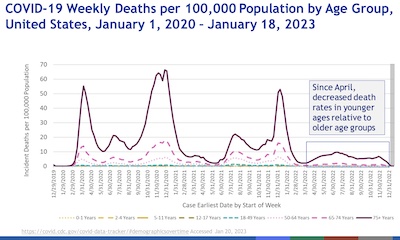
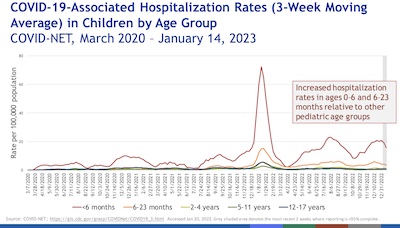
Gestae Commentaria
Comments for this post are closed pending repair of the comment system, but the Email/Twitter/Mastodon icons at page-top always work.